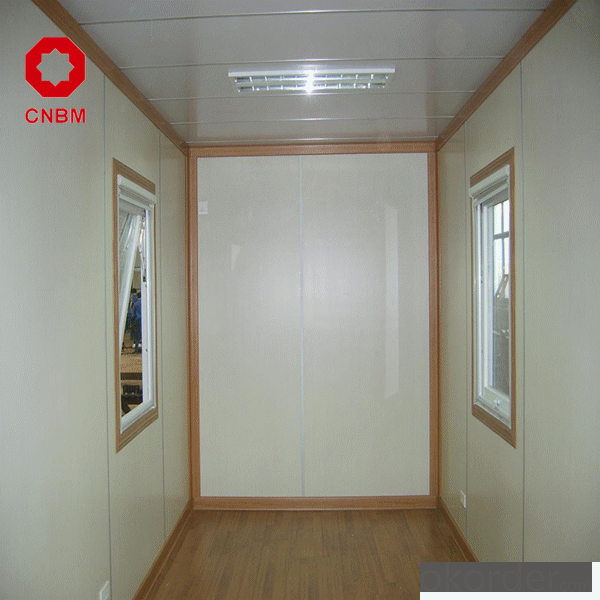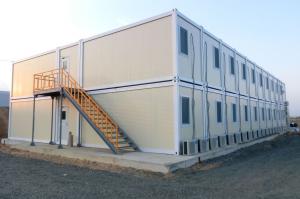Good Quality Galvanzied Steel Storage of CNBM
- Loading Port:
- Tianjin
- Payment Terms:
- TT OR LC
- Min Order Qty:
- 6 set
- Supply Capability:
- 50000 set/month
OKorder Service Pledge
OKorder Financial Service
You Might Also Like
Good Quality Galvanzied Steel Storage of CNBM
Description:
1. The house is made of light steel structure and rustproof color steel sandwich panel as wall and roof.
2. The size and layout can be designed as per customers' requirements for its flexible dimension
3. The house has waterproof structure and heating insulation material, such as EPS, Rock wool or PU Panels interlock easily to form a complete thermally efficient shell.
4. Two kinds of flooring system are available, one is steel chassis floor, the other is concrete foundation.
5. One 40’HQ container can load about 160m2 considering 75mm thickness panel for roof and wall;
6. Six skilled workers can finish 42m2 in 8 hours ;
7. The house can resist heavy wind load of 0.5KN/m2 and 7-8 degree seismic intensity.
8. DimensionAs per customer design or layoutLoading160 to 200m2 per 40’HQ container
Applications:
Family house for low income people, Temporary homes for disaster area, Holiday and vocation house…Remote site constructions camping, Warehouse , Work shop…Company office, Dining halls, Dormitories, Hospitals, Saloons, Entertainment centers…
FAQ:
1.How about the installation? For example, the time and cost?
To install 200sqm house needs only 45 days by 6 professional workers. The salary of enginner is USD150/day, and for workers, it's 100/day.
2.How long is the life span of the house?
Around 50 years
3. And what about the loading quantity?
One 40'container can load 140sqm of house.
Images:



- Q: Can container houses be designed to have a garage?
- Yes, container houses can be designed to have a garage. With careful planning and construction, containers can be modified and transformed to include a functional garage space. This can be achieved by either incorporating an additional container or section into the house design specifically for the garage, or by creatively utilizing the existing containers to create a garage area within the overall structure.
- Q: Can container houses be designed for agricultural or farming purposes?
- Yes, container houses can be designed for agricultural or farming purposes. The versatility of container houses makes them suitable for a variety of applications, including agriculture and farming. Container houses can be customized and modified to meet the specific needs of farmers and provide a comfortable and efficient space for various agricultural activities. Container houses can serve as farm offices, storage facilities, or even as living spaces for farmers and farmworkers. With proper insulation, ventilation, and electrical installations, container houses can provide a suitable environment for storing agricultural equipment and supplies. They can also be used as temporary housing for seasonal workers or as permanent residences for farmers. Moreover, container houses can be easily transported and assembled, allowing farmers to have flexible and portable structures on their agricultural land. This flexibility is particularly advantageous for farmers who need to move their operations or expand their farming activities in different locations. In addition, container houses can be equipped with hydroponic or aquaponic systems, enabling farmers to grow crops without soil or with minimal water usage. These systems can be integrated into the design of container houses, creating an efficient and sustainable environment for cultivating crops. Overall, container houses offer a cost-effective and adaptable solution for agricultural and farming purposes. They can be customized to meet the specific needs of farmers, provide a comfortable living or working space, and facilitate sustainable farming practices.
- Q: Are container houses suitable for areas with high crime rates?
- Container houses can be suitable for areas with high crime rates, but there are several factors that need to be considered. Firstly, container houses are made of steel, which is a durable material that can withstand break-in attempts. This can be an advantage in areas with high crime rates, as it can provide an added level of security compared to traditional houses made of wood or other materials. Additionally, container houses can be easily modified to include reinforced doors, windows, and other security measures to further enhance their resistance to break-ins. Secondly, container houses can be designed to have fewer access points, making it more difficult for criminals to gain entry. By limiting the number of doors and windows, it reduces the potential weak points that criminals could exploit. This can make it more challenging for them to break into a container house, thus deterring potential criminals. However, it is important to note that container houses alone cannot guarantee safety in areas with high crime rates. It is crucial to consider other security measures, such as installing alarm systems, surveillance cameras, and motion sensor lights, to provide a comprehensive security setup. Additionally, it is advisable to develop good relationships with neighbors and engage in community watch programs to increase the overall security of the area. Ultimately, while container houses can offer certain advantages in terms of security, it is essential to assess the specific circumstances and security needs of the area before determining their suitability. Professional advice from security experts or local law enforcement agencies can provide valuable insights and guidance in making an informed decision.
- Q: What is the height of the general villa?
- There are many kinds of villas, mostly true layer structure,
- Q: Can container houses be designed to have a high ceiling?
- Certainly! Container houses have the potential to feature a lofty ceiling design. Although conventional shipping containers are typically equipped with an 8-foot ceiling, they can be altered and stacked in a manner that creates a roomy and breezy interior with elevated ceilings. Through the elimination of the container's roof and the incorporation of supplementary structural support, it becomes feasible to elevate the ceiling height in accordance with specific design preferences. Moreover, the inclusion of windows or skylights serves to augment the perceived height and welcome natural light, thus imparting a sense of openness and expansiveness to the space. By conducting thorough planning and tailoring the design to individual needs, container houses can indeed boast high ceilings, thereby presenting a contemporary, fashionable, and cozy living environment.
- Q: Are container houses suitable for single-story living?
- Yes, container houses are suitable for single-story living. Container houses can be designed and modified to accommodate single-story living by incorporating all necessary amenities and living spaces on one level. Additionally, the versatility of container houses allows for customization and flexibility in design, making them a viable option for those who prefer single-story living.
- Q: Can container houses be designed with a built-in storage space?
- Yes, container houses can definitely be designed with a built-in storage space. The nature of shipping containers allows for easy customization, and architects and designers can incorporate storage areas seamlessly within the structure. This can include shelves, cabinets, closets, or even hidden compartments, maximizing the use of space and providing ample storage solutions for the inhabitants.
- Q: Can container houses be designed to have a spacious dining area?
- Yes, container houses can definitely be designed to have a spacious dining area. While the size and layout of a container may initially seem limiting, with the right design and planning, it is absolutely possible to create a spacious and comfortable dining area within a container house. One approach to maximizing the space available in a container house is through open concept designs. By removing unnecessary walls and partitions, the dining area can seamlessly flow into the adjacent living or kitchen area, creating an overall sense of spaciousness. Additionally, incorporating large windows or glass walls can bring in natural light and visually expand the space, making it feel larger and more open. Another design consideration is the use of multi-functional furniture. By choosing dining tables and chairs that can be folded or collapsed when not in use, the dining area can easily be transformed into a more open and flexible space. Storage solutions, such as built-in shelves or cabinets, can also help to declutter the dining area, allowing it to appear more spacious. Furthermore, utilizing creative storage solutions can free up floor space and contribute to a more open dining area. For example, hanging pots and pans or utilizing vertical storage for dishes and utensils can help maximize the available space in the kitchen, freeing up room for a larger dining area. In summary, with thoughtful planning, creative design solutions, and the use of multi-functional furniture, container houses can be designed to have a spacious dining area. The key is to optimize the available space and create a functional and visually appealing layout that maximizes both comfort and functionality.
- Q: What is the price of container housing?
- In fact, this mainly depends on the structure of the container and interior.
- Q: Are container houses subject to building codes and regulations?
- Yes, container houses are subject to building codes and regulations. While these houses are made from repurposed shipping containers, they still need to comply with local building codes and regulations to ensure safety, structural integrity, and adherence to zoning laws. This may include obtaining permits, meeting specific standards for insulation, plumbing, electrical systems, and fire safety, and following guidelines for structural modifications. It is important to consult with local authorities and professionals to ensure compliance when constructing container houses.
Send your message to us
Good Quality Galvanzied Steel Storage of CNBM
- Loading Port:
- Tianjin
- Payment Terms:
- TT OR LC
- Min Order Qty:
- 6 set
- Supply Capability:
- 50000 set/month
OKorder Service Pledge
OKorder Financial Service
Similar products
Hot products
Hot Searches
Related keywords


























